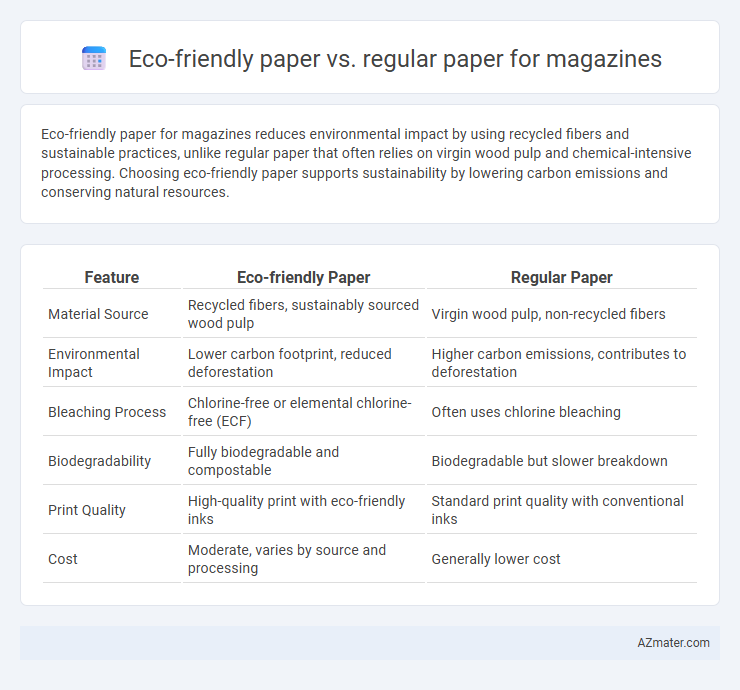Eco-friendly paper for magazines reduces environmental impact by using recycled fibers and sustainable practices, unlike regular paper that often relies on virgin wood pulp and chemical-intensive processing. Choosing eco-friendly paper supports sustainability by lowering carbon emissions and conserving natural resources.
Table of Comparison
| Feature | Eco-friendly Paper | Regular Paper |
|---|---|---|
| Material Source | Recycled fibers, sustainably sourced wood pulp | Virgin wood pulp, non-recycled fibers |
| Environmental Impact | Lower carbon footprint, reduced deforestation | Higher carbon emissions, contributes to deforestation |
| Bleaching Process | Chlorine-free or elemental chlorine-free (ECF) | Often uses chlorine bleaching |
| Biodegradability | Fully biodegradable and compostable | Biodegradable but slower breakdown |
| Print Quality | High-quality print with eco-friendly inks | Standard print quality with conventional inks |
| Cost | Moderate, varies by source and processing | Generally lower cost |
Introduction to Eco-Friendly and Regular Paper
Eco-friendly paper is produced using sustainable materials such as recycled fibers, agricultural waste, and chlorine-free processes, reducing environmental impact and conserving natural resources. Regular paper typically relies on virgin wood pulp harvested from non-recycled sources, often involving chemical treatments that contribute to deforestation and pollution. Choosing eco-friendly paper supports sustainable forestry, lower carbon emissions, and promotes a magazine production process aligned with environmental responsibility.
Environmental Impact: Eco-Friendly vs Regular Paper
Eco-friendly paper for magazines significantly reduces environmental impact by utilizing recycled fibers and sustainable forestry practices, which lowers deforestation rates and conserves biodiversity. In contrast, regular paper production often relies on virgin wood pulp, contributing to increased carbon emissions, habitat destruction, and water pollution. Choosing eco-friendly paper supports reduced carbon footprints and promotes circular economy principles by minimizing waste and energy consumption throughout the manufacturing process.
Raw Materials Used in Magazine Paper Production
Eco-friendly magazine paper primarily utilizes recycled fibers, agricultural residues, and sustainably sourced wood pulp, significantly reducing dependency on virgin timber and minimizing deforestation. In contrast, regular magazine paper is typically produced using bleached chemical pulp derived from non-renewable virgin wood, leading to higher environmental impact and increased carbon footprint. The incorporation of alternative raw materials in eco-friendly paper production enhances biodegradability and reduces toxic chemicals, supporting sustainable forestry and circular economy principles in publishing.
Manufacturing Process Comparison
Eco-friendly paper for magazines is produced using sustainable raw materials such as recycled fibers, agricultural waste, or sustainably harvested wood, minimizing deforestation and reducing carbon footprint. This manufacturing process employs less water, energy, and harmful chemicals like chlorine bleach, resulting in a lower environmental impact compared to conventional paper production, which often relies on virgin wood pulp and extensive chemical treatments. Regular paper manufacturing typically involves higher greenhouse gas emissions and pollutant discharge into water bodies, emphasizing the ecological advantages of eco-friendly alternatives in magazine printing.
Recyclability and End-of-Life Disposition
Eco-friendly paper used in magazines is typically made from recycled fibers or sustainably sourced materials, enhancing its recyclability and reducing environmental impact compared to regular paper. This type of paper often contains fewer chemicals and bleaching agents, making it easier to decompose and repurpose at the end of its life cycle. Regular paper, especially if coated or glossy, can pose challenges in recycling due to additives and finishes that hinder fiber recovery and increase landfill waste.
Print Quality and Reader Experience
Eco-friendly paper for magazines often features a matte finish that reduces glare and enhances color richness, improving print quality for vibrant images and sharp text. Readers appreciate the smoother texture and natural feel of recycled fibers, which contribute to a tactile reading experience distinct from the glossy and smoother surface of regular paper. While regular paper tends to offer brighter whites and sharper contrasts, eco-friendly options balance print clarity with sustainability, appealing to environmentally conscious audiences without compromising visual appeal.
Cost Implications for Publishers
Eco-friendly paper typically incurs higher production costs due to sustainable materials and environmentally-friendly processing methods, impacting publishers' budgets for magazine printing. Regular paper remains more cost-effective with established supply chains and lower raw material expenses, enabling publishers to maintain competitive pricing. However, eco-friendly options can enhance brand reputation and appeal to environmentally conscious consumers, potentially offsetting higher upfront costs over time.
Market Trends in Sustainable Magazine Publishing
The market for sustainable magazine publishing is rapidly shifting towards eco-friendly paper due to growing consumer demand for environmentally responsible products and stricter regulatory standards. Eco-friendly paper, made from recycled fibers or sustainably sourced materials, reduces carbon footprint and waste compared to regular paper derived from virgin wood pulp. Publishers increasingly adopt this green alternative to enhance brand image and meet the rising trend in eco-conscious readership, driving significant growth in the eco-friendly paper segment within the magazine industry.
Certification and Eco-Labeling Considerations
Eco-friendly paper used in magazines often carries certifications such as FSC (Forest Stewardship Council) or PEFC (Programme for the Endorsement of Forest Certification), ensuring sustainable forest management and responsible sourcing. Regular paper commonly lacks these certifications, potentially contributing to deforestation and higher environmental impact. Eco-labeling on magazines, including labels like Green Seal or EU Ecolabel, further verifies environmentally friendly production processes and reduced carbon footprints, which are less frequently associated with conventional paper options.
Future Outlook: Shifting to Eco-Friendly Magazine Paper
The future outlook for magazine publishing increasingly favors eco-friendly paper due to rising environmental awareness and stringent sustainability regulations. Eco-friendly paper, often made from recycled fibers and chlorine-free processes, reduces carbon footprints and aligns with consumer demand for green products. Innovations in biodegradable coatings and plant-based inks further enhance the market viability of sustainable magazine paper, positioning it as the preferred choice for publishers aiming to minimize ecological impact.

Infographic: Eco-friendly paper vs Regular paper for Magazine
 azmater.com
azmater.com